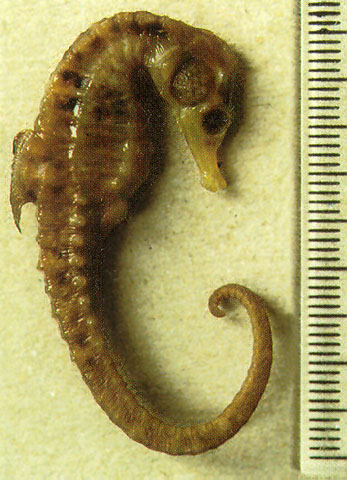| Syngnathidae (Pipefishes and seahorses), subfamily: Syngnathinae |
| 12.1 cm OT (male/unsexed) |
|
demersal; brackish; depth range 0 - 27 m, non-migratory |
| Southeast Atlantic: endemic to South Africa. Hippocampus capensis has the smallest known range of any seahorse and was the first to be assessed as threatened on the IUCN Red List, in 1994. |
|
Dorsal spines (total): 0-0; Dorsal soft rays (total): 16-18; Anal spines: 0-0; Anal soft rays: 3-3. Description: (based on 96 specimens): Adult height: 5.3-11.2cm. Rings: 11 + 34 (32-37). Snout length: ca. 3.0 in head length. Dorsal fin rays: 17 (16-18) covering 2+1 rings. Pectoral fin rays: 15 (14-17). Coronet: none, arch of neck is a smooth curve; juveniles may have a very small coronet but this disappears as they mature. Spines: none on body; very short and blunt on tail
Other distinctive characters: short snout; male with slight keel.
Color pattern: usually mottled greenish or brownish; can have scattered dark spots on body. |
| Found in bays and estuaries among submerged vegetation; diurnal (Ref. 4281, 30915). Can tolerate salinities from 1-59 ppt (Ref. 30915). Ovoviviparous (Ref. 205). The male carries the eggs in a brood pouch which is found under the tail (Ref. 205). Length type refers to Height (= from top of coronet to the tip of straightened tail). Breeding in the aquarium is possible (Ref. 130565). |
|
Endangered (EN); Date assessed: 09 March 2017 (B1ab(iii,v)+2ab(iii,v)) Ref. (130435)
|
| harmless |
Source and more info: www.fishbase.org. For personal, classroom, and other internal use only. Not for publication.

